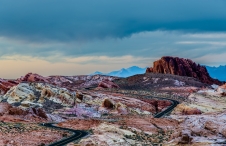Anasazi Rock Art
Anasazi and other Native American groups in Nevada came over 8,000 years ago and created a lasting legacy in rock art images carved or painted on stone surfaces. While we do not know what many of the images mean, native people living in Nevada today have traditional stories that incorporate some of the images or scenes.
Petroglyphs, carved or pecked into stone, are the most common form of rock art remaining in Nevada. Early artists sometimes chose a stone covered with a dark surface called desert varnish (or patina) and carved through the surface, creating an image in the lighter colored rock beneath. While desert varnish has covered the images, the original marks are still visible. Pictographs were painted onto the surfaces with red, yellow, and sometimes green pigments made from minerals or plants and other organic material. Over thousands of years, water, wind, and even people have washed away or damaged much of the paint, leaving only faint traces of some of these paintings.
The variety of images includes animals (zoomorphs), people (anthromorphs), and hunting scenes. Archaeologists speculate that some may be clan symbols marking locations where families lived or traveled by; some researchers think the images may have been created by religious leaders or village shamans. Some panels are composed of shapes and lines that form calendars depicting the summer or winter solstice. Archaeologists do not believe, however, that the rock art is a written alphabet.
Nevada's rock art is sacred to Native American people. The beautiful carvings and paintings were created by their ancestors and have lasted through hundreds of generations and for thousands of years. Nonetheless, it is very fragile. Covering it with chalk or paint or even rubbing or touching the images can permanently damage the designs, and spray paint, bullets, and careless actions have damaged or destroyed rock art. Laws are in place to protect Nevada's heritage of rock art on public lands.


